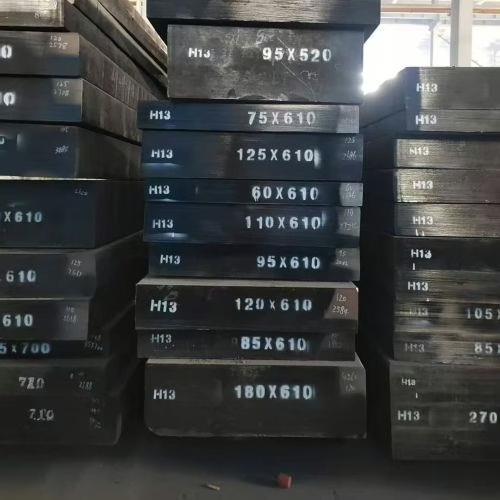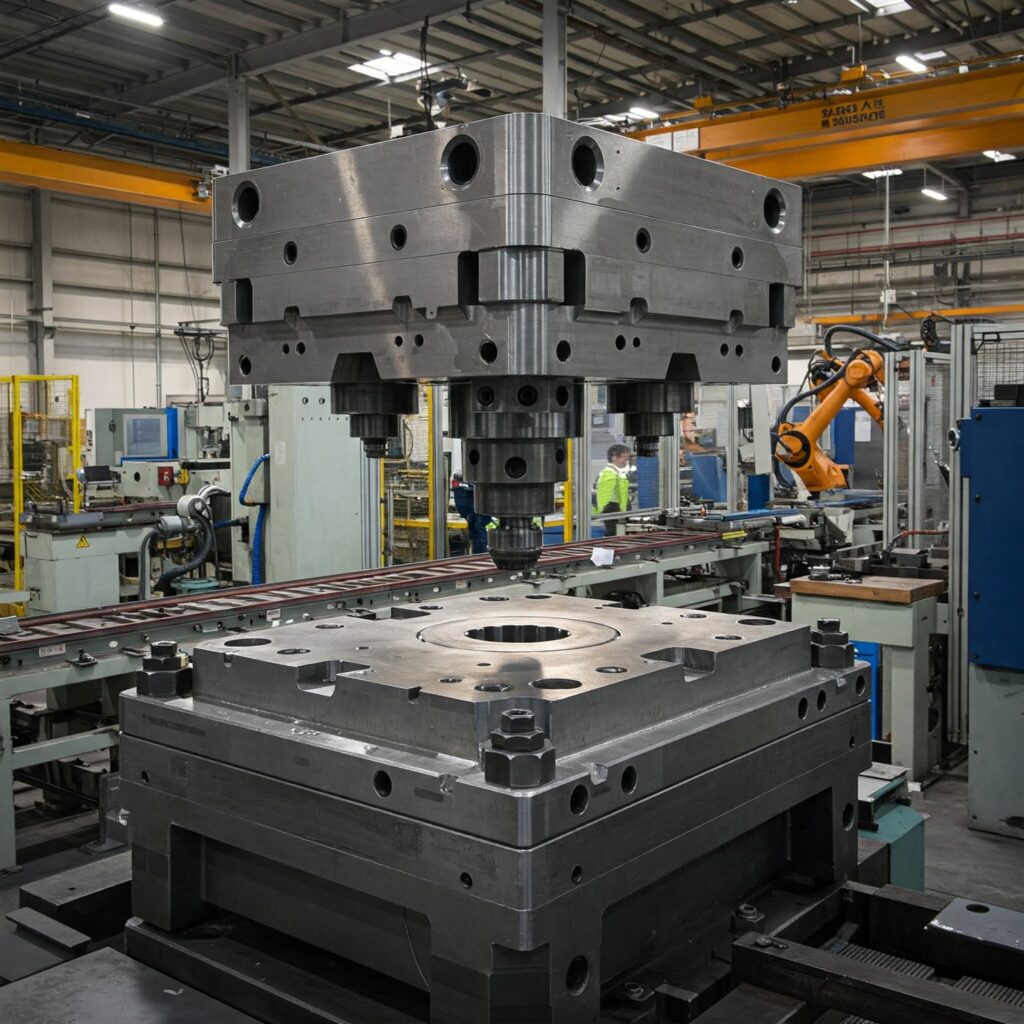Estimated reading time: 6 minutes
Key Takeaways
- H13 steel is a 5% chromium hot-work tool steel known for its high hardness and toughness, crucial for various applications.
- Key characteristics include good wear resistance, high tempering resistance, and the ability to maintain hardness at high temperatures.
- Hardness of H13 steel ranges from 40 to 56 HRC, with optimal values for die-casting tooling typically between 44–48 HRC.
- Factors influencing H13 hardness include chemical composition, heat treatment, and the presence of vanadium, which enhances wear resistance.
- Nitriding treatment significantly boosts surface hardness, achieving up to 1100 HV while maintaining excellent core strength.

H13 steel’s hardness is a key property in its applications. H13 steel is a widely used 5% chromium (Cr) hot-work tool steel, also known as 4Cr5MoSiV1, 1.2344, SKD61, with a carbon content of approximately 0.4%. It belongs to the H group of tool steels, which exhibit resistance to softening at high temperatures.
Its characteristics include:
- Hot Hardness & Temper Resistance: H13 exhibits good “red hardness” and maintains high hardness and strength at elevated temperatures, making it resistant to thermal softening. Its high tempering resistance allows it to withstand high-temperature surface treatments without significant loss of core hardness.
- Good Wear Resistance: Due to its vanadium content, H13 is very resistant to abrasion and erosive wear, especially at high temperatures.
- Toughness & Impact Strength: H13 possesses excellent impact strength and good ductility.
- Deep Hardenability: It is a deep-hardening, air-hardening steel, allowing large sections to be hardened by air cooling with minimal residual stresses.
- Good Machinability: When properly annealed, H13 has a machinability rating of 70 compared to a 1% carbon steel rated at 100. Please refer to H13 Tool Steel Machinability.
Hardness of H13 Tool Steel
For H13, increasing the hardening temperature can increase tempered hardness, but attempts to obtain excessively high hardness may lead to little or no additional hardness gain while causing a strong loss in toughness. In actual practice for dies, a compromise is made where dies are tempered to near-maximum hardness levels at which they still possess sufficient toughness to withstand loading.
The tempering process is crucial to adjust hardness and, more importantly, to increase toughness and relieve internal stresses in hardened tools.
- After air quenching, the hardness range of H13 steel is 52–54 HRC.
- After tempering at different temperatures, the longitudinal mechanical properties of H13 steel bars at room temperature are as follows:
| Hardness (HRC) | Temperature (°C) | Temperature (°F) |
| 52 | 527 | 980 |
| 50 | 555 | 1030 |
| 48 | 575 | 1065 |
| 46 | 593 | 1100 |
| 44 | 605 | 1120 |
- For die-casting tooling, the optimum working hardness for H13 is typically 44–48 HRC. For tooling requiring shock resistance, it is 40–44 HRC. H13 combines good red hardness, abrasion resistance, and resistance to heat checking at hardness levels ranging from 45 to 50 HRC.
- The typical core hardness for H13 after nitriding is ~45 HRC, with surface hardness exceeding 1000 HV (>70 HRC).
- When used in extrusion processes, H13 has a hardness of 48–52 HRC for punches and dies. In hammer forging and mechanical press forging, H13 dies have a hardness range of 47–56 HRC.
Factors Influencing H13 Hardness
Two factors influence the hardness of H13 steel: chemical composition and heat treatment process.
The hardness, strength, wear resistance, and tempering resistance of H13 primarily stem from its alloying elements, particularly vanadium (V). Compared to H11, H13 possesses a higher vanadium content, promoting the dispersion of high-hardness MC-type vanadium carbides.
At the micro level, H13’s hardness depends on two factors: the hardness of the martensitic matrix and the quantity and type of carbides distributed within it. During tempering, the co-precipitation of MC-type carbides alongside molybdenum-rich carbides (M6C) and chromium-rich carbides (M23C6) is the primary driver of the secondary hardening effect.
During the heat treatment process of H13 steel, the standard austenitizing temperature is approximately 1030°C, which determines how much carbon and alloying elements can dissolve into the austenitic matrix. The more complete the dissolution, the higher the hardness of the martensite formed after quenching. H13 exhibits a relatively flat tempering curve, yielding similar hardness values across a broad temperature range.
* All specimens air cooled from 1025 °C (1875 °F) and tempered 2 h at temperature. AQ, as-quenched. Please refer to H13 steel heat treatment.
Hardness and Toughness of H13 Steel
There exists a significant inverse relationship between hardness and toughness. While increasing hardness enhances a mold’s resistance to wear and plastic deformation, this inevitably comes at the expense of the steel’s toughness. Experimental data indicate that as the hardness of H13 steel increases, its Charpy V-notch impact energy exhibits a decreasing trend.
Therefore, in practical engineering applications, avoid pursuing the maximum hardness of H13. Excessively high hardness leads to a sharp reduction in toughness, significantly increasing the risk of premature cracking and failure in the mold.
For applications subjected to severe impact, such as hot forging dies, it is generally recommended to control hardness at the lower end of the recommended range, e.g., 40–44 HRC, to prioritize die toughness and prevent brittle fracture.
Surface Hardness Enhancement: Nitriding H13 Steel
For applications requiring extremely high surface hardness, H13 is an excellent candidate material for nitriding treatment. The key reason H13 responds well to the nitriding process lies in its high chromium (Cr) content.
Nitriding is a thermochemical treatment process that involves diffusing nitrogen into the surface of steel, where it combines with alloying elements like chromium in the substrate to form extremely hard chromium nitride, creating a tough protective layer. Data indicates that post-nitriding H13 steel can achieve surface hardness approaching 1100 HV. This exceptional surface hardness directly translates into outstanding wear resistance, making it highly suitable for high-temperature forming processes with severe abrasion, such as hot forging and extrusion.
Beyond its exceptional surface hardness, H13’s other significant advantage during nitriding is its core stability. Many different steel grades experience significant softening in the core during the high-temperature nitriding process, resulting in insufficient support strength. H13, however, maintains excellent core hardness at nitriding temperatures, typically around 45 HRC. This combination of a high-hardness surface layer and a high-strength core enables it to withstand demanding conditions involving both severe wear and exposure to heavy impacts or extremely high unit loads. It prevents the surface-hardened layer from spalling due to matrix collapse.


